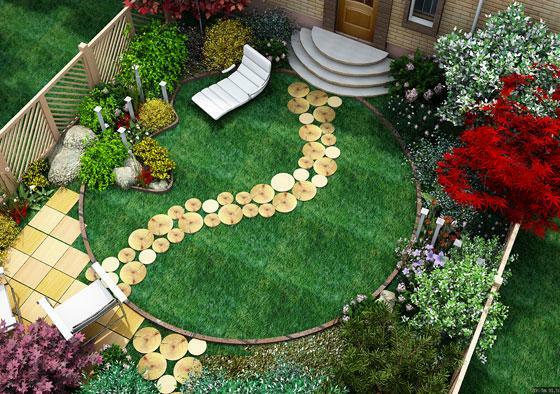Pile Foundation: 2 main varieties and techniques of self-device
Table of contents
-
1 Features of pile foundations
- 1.1 varieties piles
- 1.2 Methods for installing piles
- 1.3 Reasons for application
-
2 techniques devices
- 2.1 Method 1. Fill bored designs
- 2.2 Method 2. Installing screw supports followed betonirovkoy
- 3 Pros and cons of bases
- 4 conclusion
To design and build a pile foundation with his own hands, it is necessary to examine a large amount of information. This article contains information about the main varieties of piles and their features, and provides algorithms for self-installation of pile foundations.
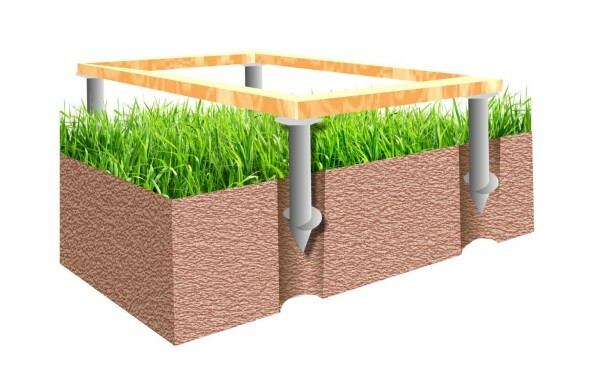
Vertical ground support possible to build even on difficult terrain
Features of pile foundations
varieties piles

Schematic representation of the different types of piles
Pile - is an elongated support structure, which is immersed in the soil to provide the necessary bearing capacity of the ground. Piles can be placed in the ground either vertically or at an angle - it depends on what kind of load they will accept.
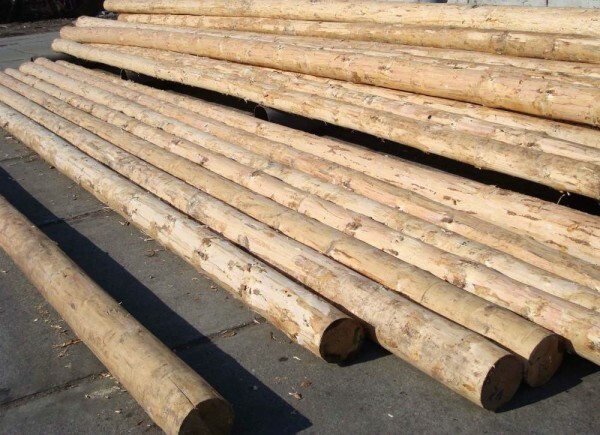
wooden poles
Piles are divided into groups based on a number of grounds. The most relevant classification will be given below.
The material of manufacture:
- wood;
- reinforced concrete;
- concrete;
- metal;
- combined (+ metal wood or concrete + metal).
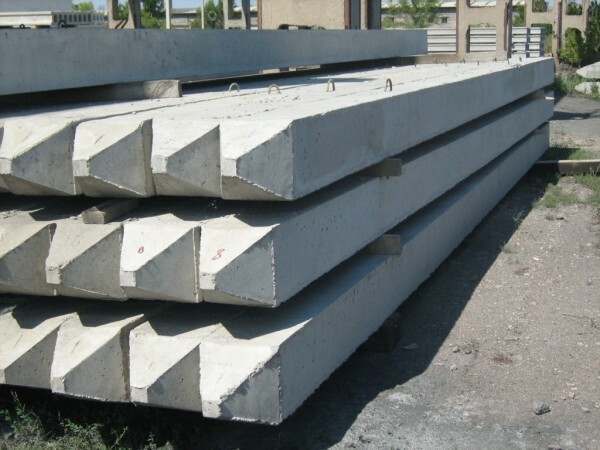
Concrete products for industrial production
By way of immersion:
- precast - sink into the ground mechanically (harvesting, burozabivka, vibro).

The difference between the form of driven and printed designs
- Printed - are formed directly in the soil column by filling the drilled hole with concrete. May additionally be amplified from a metal reinforcement;
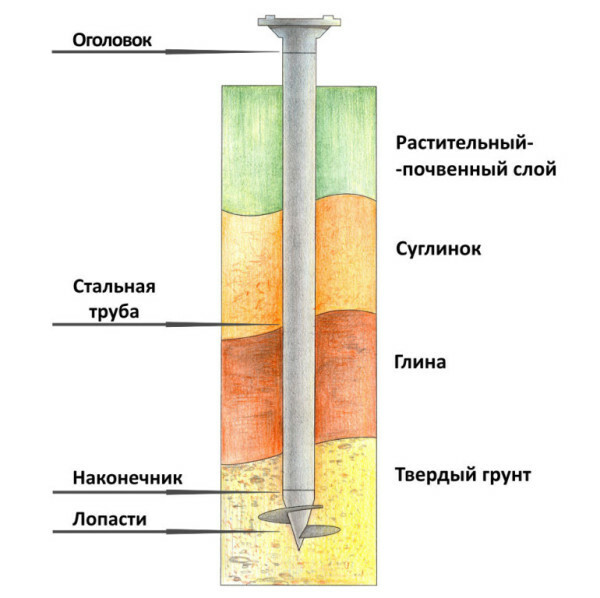
Coil design
- Screw - the lower part of the pile is equipped with a conical nozzle vane. When submerged nozzle is screwed into the soil while simultaneously densifying it, which provides reliable fixation support.
By type of impact on soil:

Left - floating pile, right - Front
- Hanging - are held in position by the friction of the ground pin piles. May produce a precipitate;
- pile-stand - based on a dense base which typically is under a layer of soft soil. Draft of such structures is minimal.
Pile foundation can be constructed using any variety of items. However, the usefulness of the complexity of the construction and will be different for different designs, because, in practice, in a private building used only some of them.
Methods for installing piles
Foundations using underground vertical supports can be designed according to different schemes. Placing piles depends primarily on the characteristics of the objects, they will provide a load-bearing capacity.
piles arrangement may be as follows:
- Single. Set or a light construction angles (brick house), or a small area of the vertical elements (racks, columns). It is also possible to tab support piles for the foundation elements loaded (e.g., at the base of the furnace).
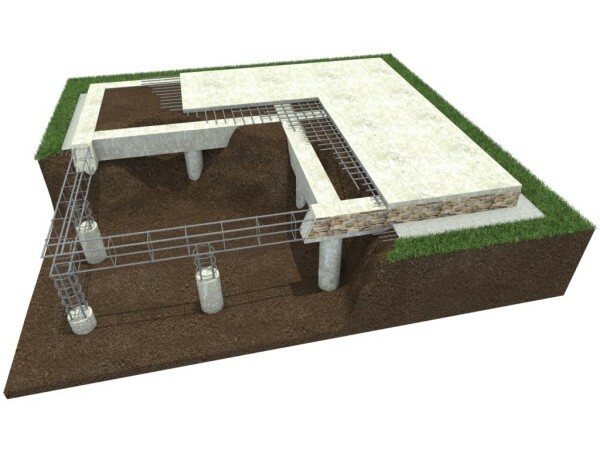
A tape base Reinforced concrete piles of
- Belt. Represent pile rows (screw, driven piles or packed), united in a single structure. Mounting strip foundation is done under the load-bearing walls and other extended objects.
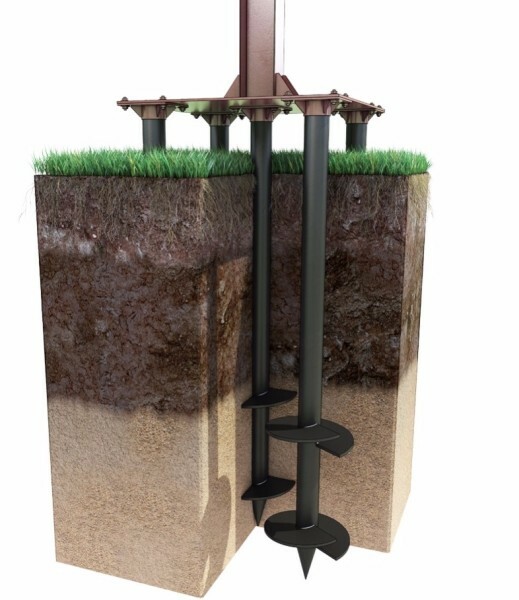
"Bush" for the massive support
- Bushes. Several piles installed close to each other under the loaded object. Typically, a scrub column under resistant or severe internal base structure.
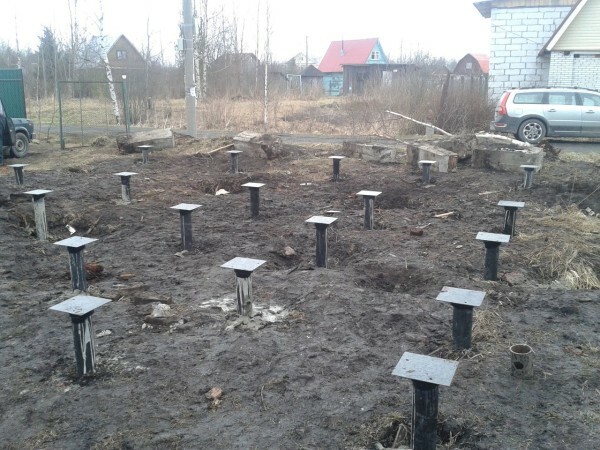
pile field
- Field. Foundation pile of this type is a system of the single long bush and belts mounted on a limited area. It provides a good load-bearing capacity can be erected under the multi-storey building.
The piles for the foundation are used not singly but as part of the bush, ribbons or fields, usually combined with a special design - grillage. Gratings are made of concrete, metal or wood.
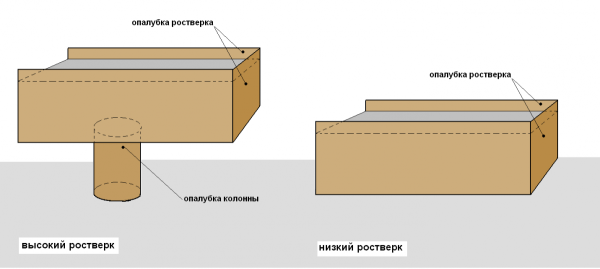
design grillages
Depending on the placement of gratings are:
- low - located below ground level. Because of this pile foundation supports the load across the surface (the ground part is transmitted) instead of the individual supports, which increases the total bearing capacity.
- rise - disposed immediately above the ground surface. The construction of elevated pile cap eliminates the transmission load on the ground, which is important in the construction on the ground moving.
- tall - are established at a considerable height. Construction of pile foundation with high grillage practice in the construction of hydraulic structures, as well as in the construction of buildings with large underground spaces.
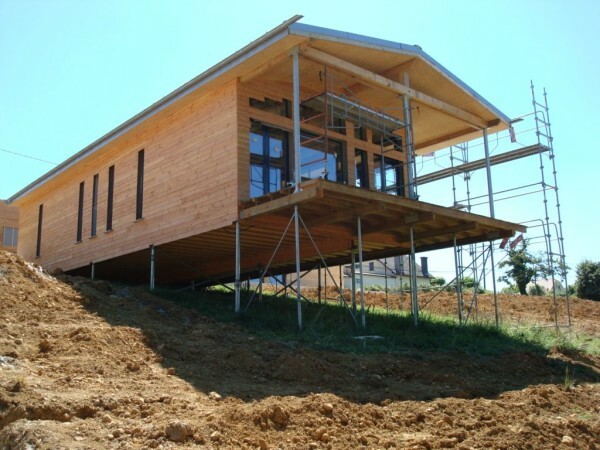
Example of the high grillage
Reasons for application
Apparatus pile foundation is carried out for several reasons:

The design allows you to go through soft ground
- Construction on soft ground - fluid or clay loam, loess basis, quicksand, topsoil, etc. In this case, the installation of deep underground supports provides load transfer structure of a denser bottom lying under weak layer.
Also similar effective base during freezing heaving soil to a depth of 1.5 m or more.
- The need for saving time and money. Erecting a house on stilts with their own hands, we not only reduce the amount of earthworks and concrete consumption, but also significantly reduce the duration of the project.
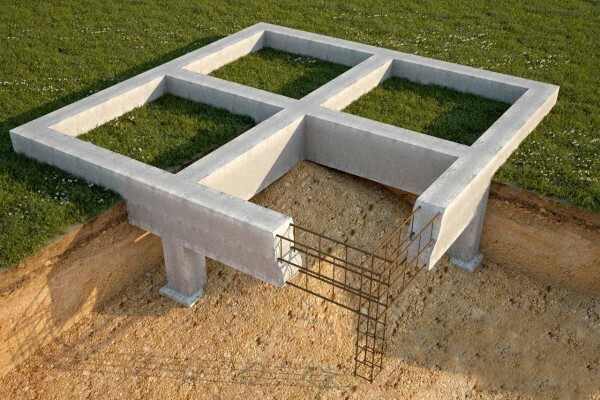
The combination of the belt base supports with recessed
- Compensation for the disadvantages of the belt or columnar base. If the calculation result is that to ensure the desired bearing capacity is necessary to build too wide (1.5 m or more) belt monolith, then it is replaced with the pile structure.
Also, the base of the concrete piles and other support structures with significant recessed can be used as an additional, combining it with other types of foundations.
techniques devices
Method 1. Fill bored designs
With the construction of two types of pile structures used private houses:
- base of bored piles;
- Screw-pile foundations.

Pile Foundation wadding type raft of reinforced concrete
This technology is bored section base device will be described.
- Pouring piles performed using concrete mortar. One cubic meter of concrete taken cement M400 290 kg, 260 kg and 1375 kg of sand gravel. The optimum moisture content - not more than 70% by weight of cement.
- To operate using either a conventional anchor truck, or a special drill TISE, allowing to form an extension at the bottom of the nest under the pile.

Anchor truck for forming the bottom of broadening
- Also highly desirable it is to have a vibrator. Vibratory processing to minimize the amount of entrained air in the solution. With this pile body will be more dense, which means - more durable.
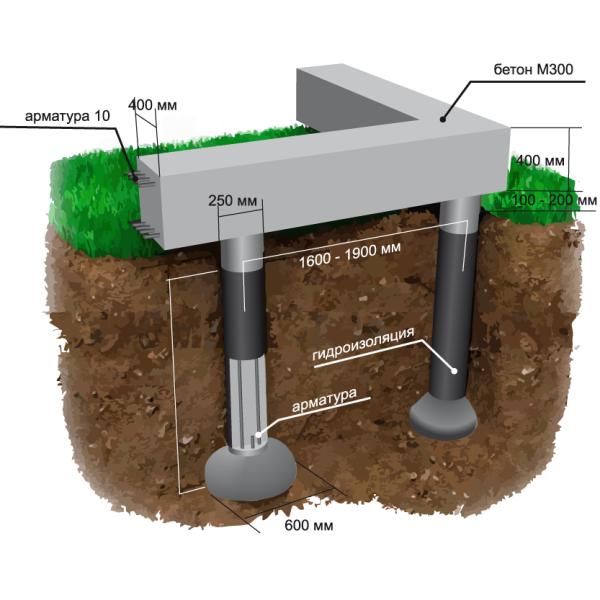
Base TISE - scheme of the device
Number of piles is chosen depending on the load-bearing capacity, which, in turn, depends on the soil type and the size of the pile. For supports TISE can use this table:
| type of soil | base resistance, kg / m2 | The bearing capacity of the support, that is, when the base diameter, mm | |||
| 250 | 400 | 500 | 600 | ||
| Clay | 6,0 | 2,9 | 7,5 | 11 | 17 |
| Loam | 3,5 | 1,7 | 4,4 | 6,9 | 10 |
| sandy loam | 3,5 | 1,7 | 4,4 | 6,9 | 10 |
| sand average | 5,0 | 2,5 | 6,3 | 10 | 14,7 |
| Bulk primer (seal) | 1,5 | 0,7 | 1,9 | 2,8 | 4,2 |
| Bulk ground (without seal) | 1,0 | 0,5 | 1,3 | 2,0 | 2,8 |
Focusing on the design load of the structures and flattening into account the carrying capacity of the support received, calculates the required number of piles for the foundation of the device.
bored mounting structure technology is described in the table:
| illustrations | The procedure works |
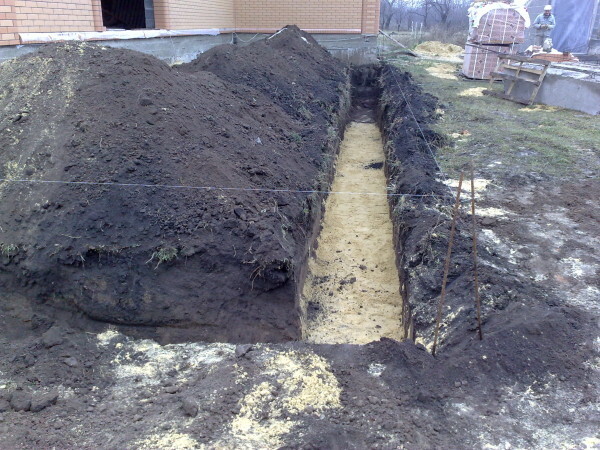 |
Preliminary work. On the portion applied markings marked point of pile installation. When installing low grillage underneath it dug trench and mounted formwork. |
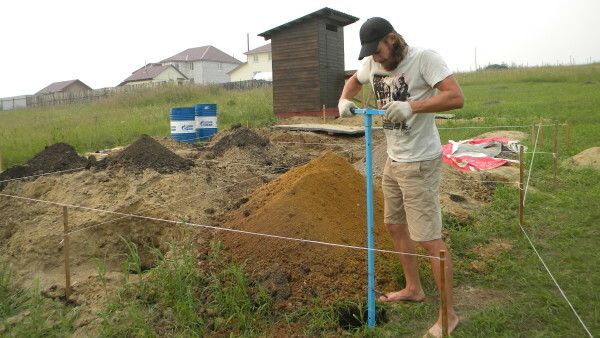 |
Drilling. With anchor truck of layout design is performed on the drilling depth (minimum of 1500 mm). When the device TISE piles at the bottom of each pocket is expanding to form the supporting sole. At the bottom of the recesses is filled with 10 - 30 cm of sand, after it is sealed bedding. |
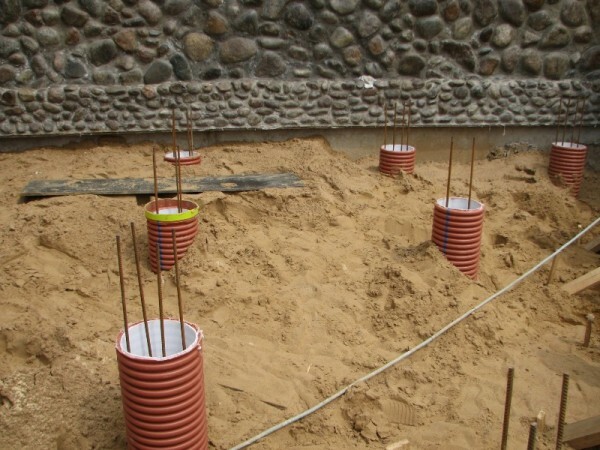 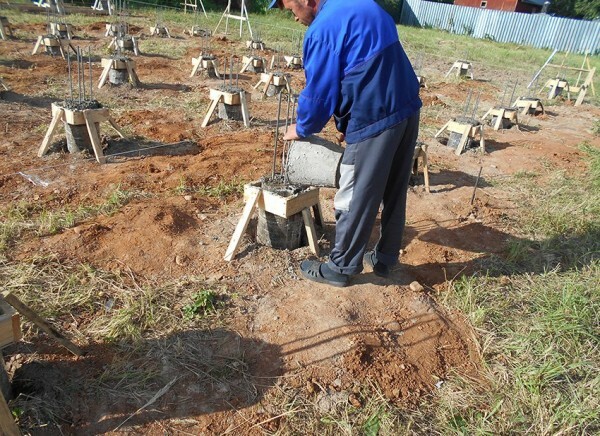
|
Pouring. The socket is inserted into the shell of the roofing material or dense glassine. Set reinforcement cage. The shell is filled with concrete which is compacted using the deep vibrator. In the absence of the vibrator sealing solution is made by compaction using hand tools. |
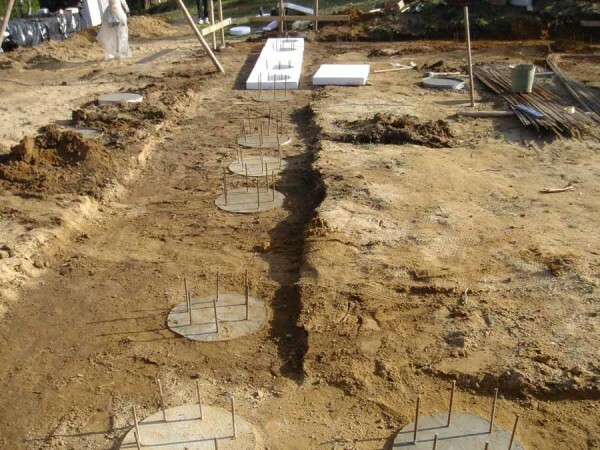 |
Finishing work. After about 3 - 4 hours after setting concrete structures spilled water and then are covered with polyethylene for curing. The formwork raft foundation is laid reinforcement cage, and then executed shading grillage. Grillage also sealed vibrator and dried under polythene. |
Method 2. Installing screw supports followed betonirovkoy
The scheme and mounting technology foundation for screw piles differs from that described above, and rather strongly.
The main difference lies in the basic design of the bearing element:
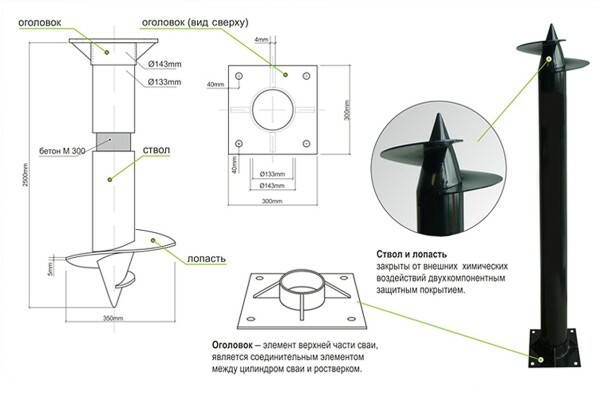
The design of the bearing element
- A spiral pile is a thick-walled metal tube which after installation in the ground filled with concrete mortar.
- In the lower part of the tube is mounted a conical spearhead facilitating the immersion of the pile.
- For burying a support by rotating screw attached to the tip of the blade. Thanks to their presence pile itself works as a drill.
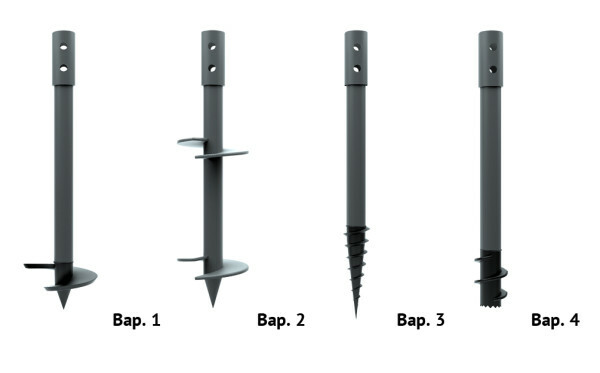
Different tips on a screw pile
by pile-screw base guide device represented in tabular form:
| illustrations | The procedure works |
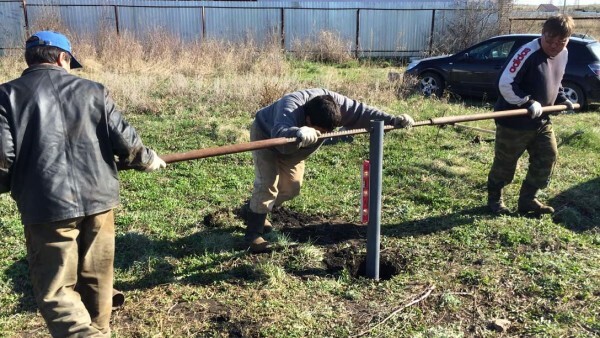 |
Immersion. Installation of screw piles marking is done by screwing into the ground. The works can be carried out both with the help of special equipment, and manually. When screwing strictly controlled vertical axial portion. Leader drilling is used in exceptional cases, if necessary, the immersion in a very firm ground. Usually standard for immersion piles enough effort teams 2 - 4 people. |
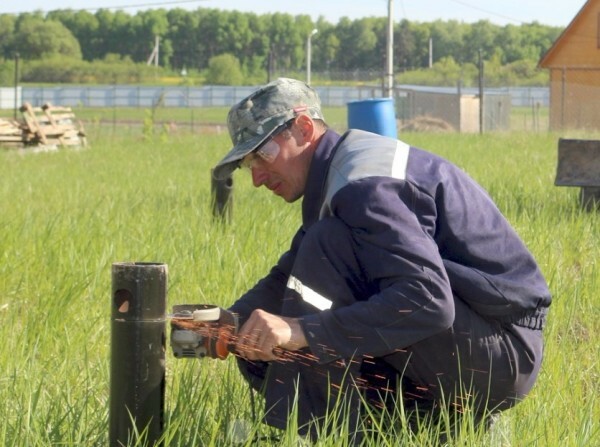 |
Trimming. Protruding above the bottom of the pile are cut off at the desired level. This allows to obtain a perfect plane regardless of the depth of immersion of each individual bearing. |
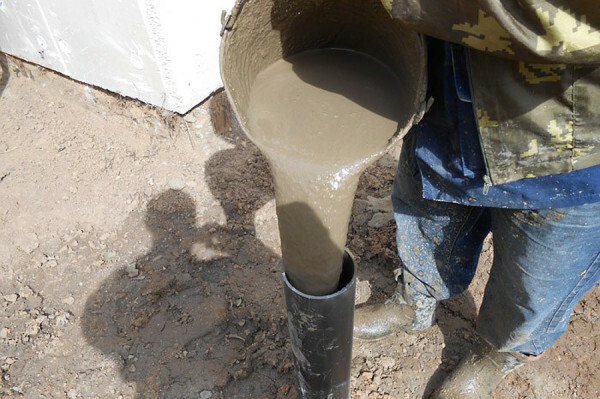 |
Pouring. Internal cavities are filled with a cement-sand mortar or concrete. Besides imparting strength contribute displace oxygen and thus, reduces the intensity of corrosion of the inner supports. |
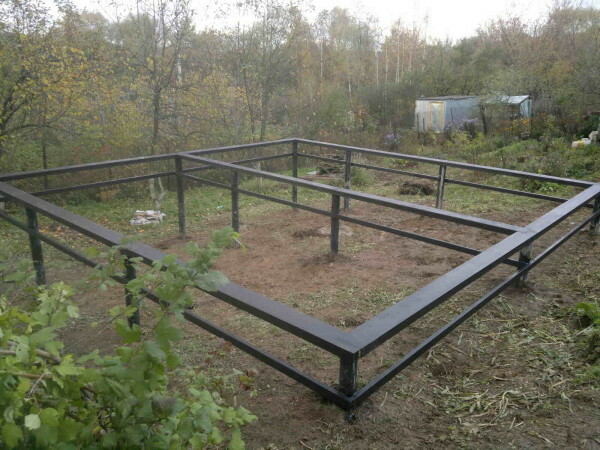 |
Tying. To the top of the piles are welded end walls with bearing pads that provide the perception and weight loads. Instead of individual end walls can be mounted grillage (harness). For the manufacture of raft foundation is most often used channel, which is placed on a pile, aligned and welded to it. |
In contrast, the medicine, the helical foundation is being built much faster and with less effort. In addition, despite the need to purchase expensive enough supports its total cost will also be lower.
Product price depends on the length, diameter and design features. The cheapest varieties cost from 750 rubles and more expensive piles with reinforced tips and anticorrosive coating will cost you a minimum of 1200 rubles / piece.
Pros and cons of bases
Although the pile foundation and is not universal, it has both advantages and disadvantages.
The main advantages:
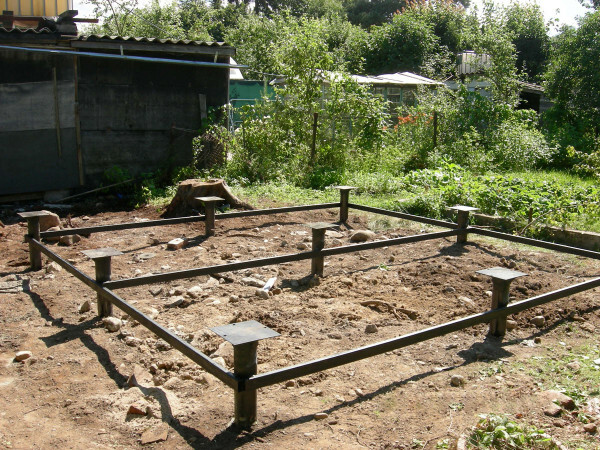
Built on stilts can be almost anywhere!
- The possibility of the construction of buildings on almost any ground. Provided professional designing and correct implementation of the project can choose a design of pile foundation, which will provide the necessary building a margin of safety and reliability.

Earthwork using piles will be much lower than when pouring monolith
- Minimizing the cost and accelerate the construction of. This is primarily achieved by reducing the amount of excavation, because it does not require massive excavation for pile structures.
- Soil compaction when immersed unnotched - the screw varieties is an additional plus.
- The possibility of failure of the "wet" processes. Installation svaynovintovogo foundation significantly reduces the operating time. While conventional pouring concrete foundations requires significant time to dry the solution.
The main disadvantages:
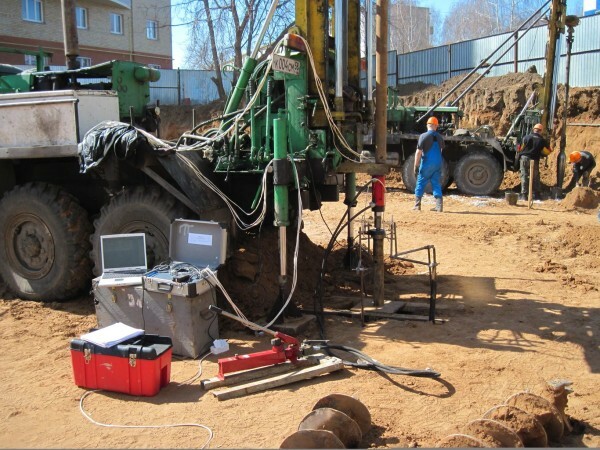
To evaluate the bearing capacity of the soil and geological surveys without impossible
- Complex and costly design work.
- The need for geological survey to evaluate the bearing capacity of the soil.
- The need for devices grillage to consolidate piles into a single system.
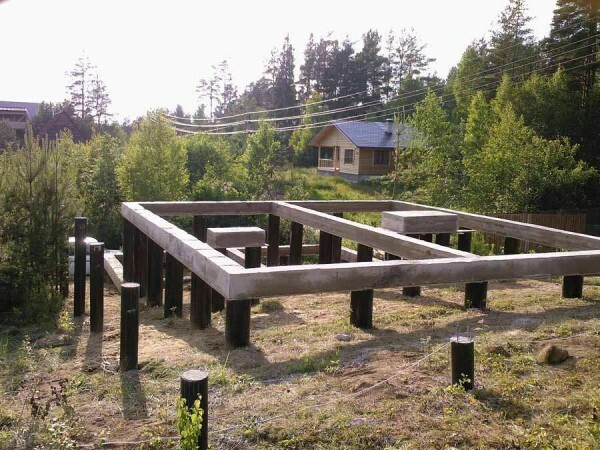
Installation of grillage (pictured) - a costly and time-consuming part of the job
- The complexity (and sometimes impossible) device basements and underground spaces, basements, etc.
- The relatively high cost of parts in the device of screw base -.
Despite these shortcomings, this foundation is one of the most popular engineering solutions, including - in private construction.
conclusion
Pile Foundation - design, quite demanding to the quality of everything. If done correctly (this will help you tips, charts and video in this article), the foundation of a reliable and durable. Answers to questions about the technology described can be obtained in the comments below.


